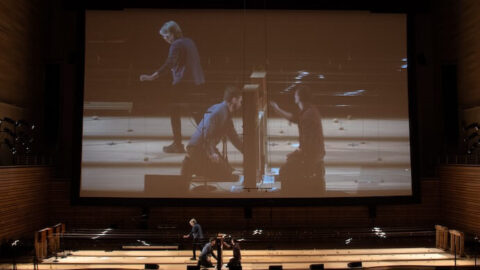Ellen Fullman’s Long String Instrument was almost invisible on stage at the Experimental Media and Performing Arts Center (EMPAC) the evening of Oct. 24. The 136 metal strings, each approximately 50 feet long and pulled taut across the stage, could only be seen when the room’s honey-colored lights glinted off them. It was as if the instrument had become so much a part of the room that it disappeared. But the second that Fullman crawled into it and began to play her piece, Elemental View, the otherworldly hums of the Long String Instrument filled the room to the brim, showing the immense resonance within it.
Developing the Long String Instrument has been Fullman’s focus for more than 40 years. A meticulously crafted tool, it is as much an art installation as it is a musical instrument. In any space it inhabits, it takes on a different sound. It’s like a cavernous violin made for spelunking; the room becomes the body, and the strings invite us inside. To that end, instead of holding it in her hands, Fullman steps into it, immersing herself in the instrument. With rosin on her fingers, she grasps the strings between her forefinger and thumb, and paces back and forth, running her fingers along different combinations of strings. While she plays, the instrument emits raspy drones that crescendo and decrescendo with the speed of her steps, like waves coming into shore.

With Elemental View, Fullman foregrounded the Long String Instrument’s many resonant tones. Performed by Fullman and The Living Earth Show, the duo of guitarist Travis Andrews and percussionist Andy Meyerson, the piece sought to celebrate the special physicality of the instrument. Fullman originally envisioned the six-part piece as a film, during the height of COVID-19 lockdowns. In the live performance, she combined music with an onscreen projection that zoomed in on the players’ hands and bodies, giving an in-depth look into their process. The performance was also delicately choreographed: The three musicians entered the instrument at once, in lockstep with each other, and they glided through its body with careful attention. Their slow movements mimicked the gradual ebb and flow of the sounds they played, as though they had melded into the instrument.
While Fullman often uses the Long String Instrument to play sprawling drones, much of Elemental View is surprisingly upbeat. Throughout the performance, Andrews’ lap steel guitar and Meyerson’s santur (a type of hammered dulcimer) joined the Long String Instrument, letting the textures and timbres intertwine and clash. Fullman created long tones that gently flowed between bright and dark harmonies, taking their time to unfold, while Andrews and Meyerson played interwoven rhythms on the instrument using mahogany-toned wooden blocks called “box bows” and “shovelers,” both invented by Fullman. The Living Earth Show’s punchy rhythms and simple, syncopated patterns added buoyancy and filled out the music, giving it the feeling of a sunny afternoon jaunt. Each of their parts contrasted with the Long String Instrument’s ever-present echo, giving it a shimmering quality.

But when Andrews and Meyers joined Fullman on lap steel guitar and santur, the three musicians felt disconnected. The lap steel’s hazy glissandos seemed out of place with the razor-sharp texture of the Long String Instrument, and the santur’s twinkling patterns could barely be heard over the reverberation. Their interwoven melodies often sounded mushy, losing definition within the resonant quality of the music.
However, when it all came back to the Long String Instrument, the music felt alive. Though the instrument may have been nearly invisible to the eye, the second it started to sound, it never escaped the audience’s attention. The instrument was in a state of infinitesimal expansion and it felt endless. Even when Fullman touched the strings for the last time, its gravelly vibrations continued to ring — long after the last note.
I CARE IF YOU LISTEN is an editorially-independent program of the American Composers Forum, and is made possible thanks to generous donor and institutional support. Opinions expressed are solely those of the author and may not represent the views of ICIYL or ACF.
You can support the work of ICIYL with a tax-deductible gift to ACF. For more on ACF, visit the “At ACF” section or composersforum.org.
























